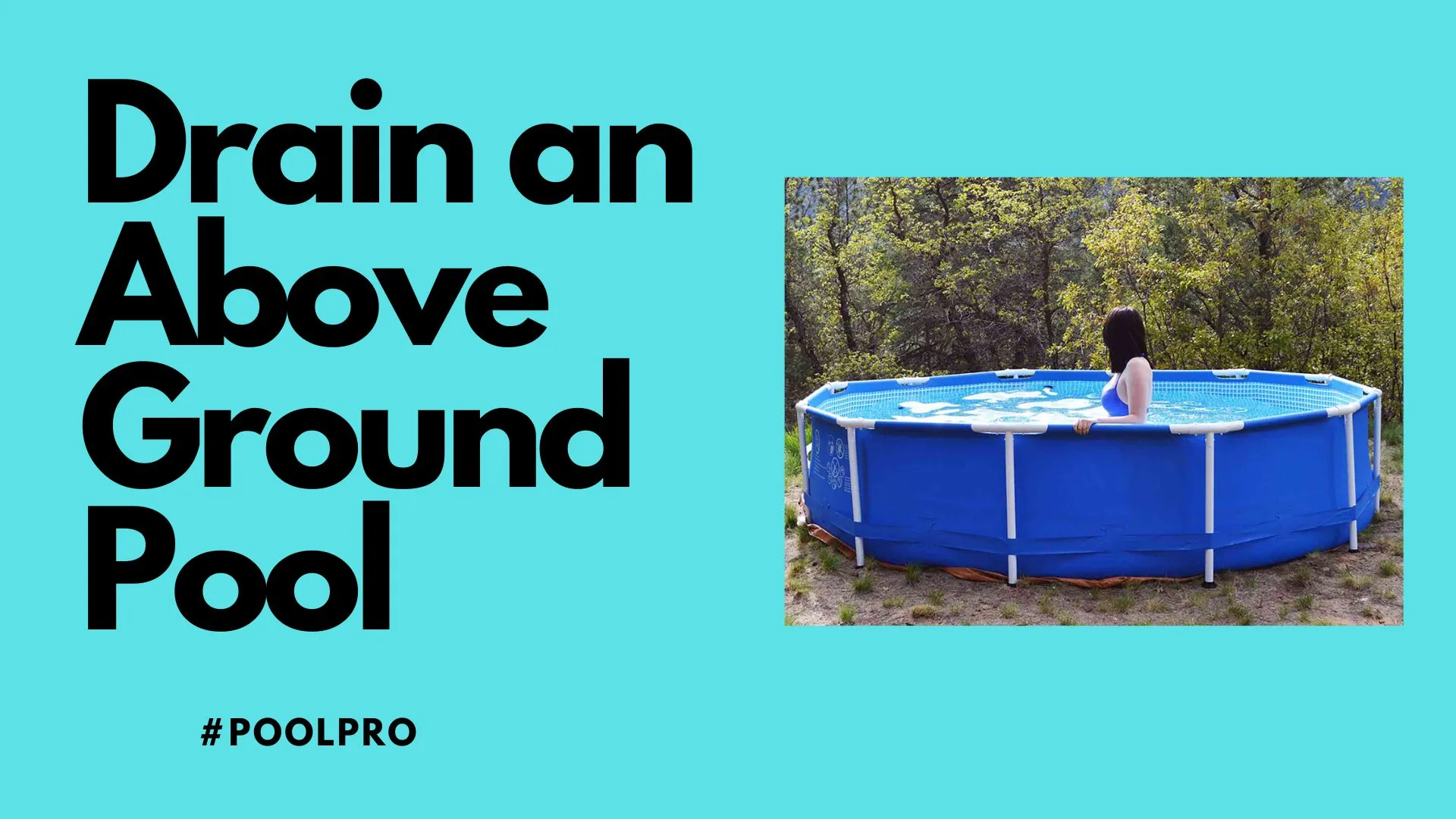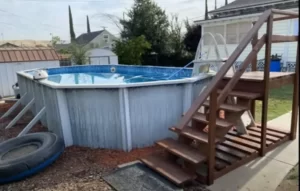Having an above-ground pool can provide endless hours of enjoyment and relaxation during the summer months.
However, there may come a time when you need to drain your pool for maintenance or to prepare it for the winter season. Knowing how to drain an above-ground pool properly is crucial to ensuring the process goes smoothly and without any damage to your pool or surroundings.
In this guide, we will walk you through the step-by-step process of draining an above-ground pool and provide valuable tips to make the task easier and more efficient.

Contents
Why Drain an Above Ground Pool?
Draining your above ground pool periodically is necessary for several reasons. Firstly, it allows you to clean and maintain your pool more effectively.
By draining the water, you can remove debris, leaves, and other impurities that may have accumulated over time. Additionally, draining the pool is crucial when you need to perform repairs or replace certain pool components.
When to Drain an Above Ground Pool
Determining the right time to drain your above ground pool depends on various factors.
If you live in an area with freezing winters, it’s recommended to drain your pool before the winter season to prevent damage caused by ice formation.
Similarly, if you notice a significant deterioration in water quality, despite regular maintenance, it might be time to consider draining and refilling the pool.
It’s important to keep in mind that excessive draining can also lead to pool damage, so it’s best to find a balance and not drain the pool more frequently than necessary.
Preparing for Pool Draining
Before you start the pool draining process, it’s crucial to prepare the surrounding area to minimize potential damage and ensure a smooth operation. Here are a few steps to follow:
- Remove any pool accessories: Take out ladders, floating devices, and any other accessories from the pool.
- Trim nearby vegetation: Trim any plants, trees, or shrubs near the pool area to prevent debris from falling into the pool during the draining process.
- Check the drainage area: Ensure that the area where you plan to drain the pool has proper drainage to prevent flooding or water damage to your property.
How to Drain an Above Ground Pool
There are a few different methods you can use to drain an above ground pool. We will discuss the three most common methods below:
Using a Submersible Pump
One of the most efficient ways to drain an above ground pool is by using a submersible pump. Follow these steps to drain your pool using this method:
- Prepare the pump: Ensure the pump is clean and in good working condition. Connect the appropriate hoses to the pump.
- Find a drainage point: Locate a suitable area where you can drain the pool water. It could be a sewer drain, a downhill slope, or any other suitable outlet.
- Submerge the pump: Lower the pump into the pool, ensuring that it is fully submerged in water.
- Start the pump: Turn on the pump and let it run until the pool is completely drained. Monitor the process to prevent any issues or overheating.
- Clean and store the pump: Once the pool is drained, clean the pump and store it properly for future use.
Using a Pool Drain Valve
If your above ground pool is equipped with a drain valve, you can use this feature to drain the pool. Here’s how:
- Locate the drain valve: Find the drain valve at the bottom of your pool. It is usually located near the pool’s filtration system.
- Attach a hose: Connect a hose to the drain valve. Make sure the hose is long enough to reach your desired drainage area.
- Open the valve: Slowly open the drain valve, allowing the water to flow through the hose and out of the pool.
- Monitor the process: Keep an eye on the draining process to ensure it’s progressing smoothly. Adjust the valve as needed.
- Close the valve: Once the pool is drained, close the drain valve securely.
Using a Siphon
If you don’t have access to a pump or a drain valve, you can use a siphon to drain your above ground pool. Follow these steps:
- Attach a hose: Connect a long garden hose to a water source, ensuring it is fully submerged in the pool.
- Create a siphon: Place one end of the hose inside the pool and create a siphon by sucking on the other end until water starts flowing.
- Direct the flow: Once the water starts flowing, carefully direct the hose to your desired drainage area.
- Monitor and adjust: Keep an eye on the siphoning process and adjust the hose as needed to maintain the flow.
Common Mistakes to Avoid
While draining an above-ground pool might seem like a straightforward task, there are a few common mistakes you should avoid:
- Overdraining the pool: Draining the pool more frequently than necessary can lead to structural damage and premature wear.
- Neglecting safety measures: Always follow safety guidelines when working with electrical equipment or near the pool area.
- Not considering local regulations: Check with your local authorities to ensure you comply with any regulations regarding pool draining and water disposal.
Frequently Asked Questions
Can I drain my above ground pool into the street?
No, it is generally not recommended to drain your above ground pool directly into the street. The water from the pool may contain chemicals and contaminants that can be harmful to the environment and may violate local regulations. It’s best to find a suitable drainage area on your property or consult with local authorities for proper disposal methods.
How long does it take to drain an above ground pool?
The time it takes to drain an above ground pool can vary depending on the size of the pool, the draining method used, and the water flow rate. On average, it can take anywhere from a few hours to a full day to completely drain an above ground pool.
Should I use chemicals when draining my pool?
In most cases, it is not necessary to use chemicals when draining an above ground pool. Chemical treatments are typically used for maintaining water quality during regular pool use. However, if you notice any signs of algae or bacterial growth in the pool, it’s advisable to address those issues before draining to prevent further contamination.
Can I use a garden hose to drain my above ground pool?
Yes, you can use a garden hose to drain your above ground pool, especially when using the siphoning method. Just make sure the hose is long enough to reach your desired drainage area and that the water flow is directed away from any structures or sensitive areas.
Do I need to remove the pool liner before draining?
In most cases, you do not need to remove the pool liner before draining an above ground pool. The pool liner is designed to withstand exposure to water and can be drained along with the pool. However, if you are planning to perform repairs or replace the liner, draining the pool completely may be necessary.
What should I do after draining the pool?
After draining the pool, it’s essential to clean the pool thoroughly, remove any remaining debris, and inspect the pool for any signs of damage or wear. You can also take this opportunity to perform any necessary maintenance or repairs before refilling the pool with fresh water.
Conclusion
Knowing how to drain an above ground pool is a valuable skill for any pool owner. By following the correct procedures and using the appropriate draining method, you can ensure the process is efficient and safe. Remember to always consider the size of your pool, local regulations, and safety measures when draining your pool. With proper maintenance and care, your above ground pool will continue to provide enjoyment and relaxation for years to come.

My name is James A. Bright, and I have worked in the pool and plumbing industries for over 15 years. I started poolprosoutions.com to share my experience with you guys. Here, I provide helpful guides and tips related to pool care, hot tub care, underground water leaks, and pipe leaks.



